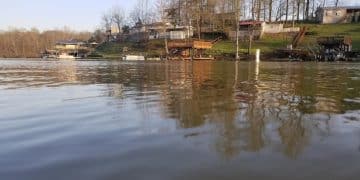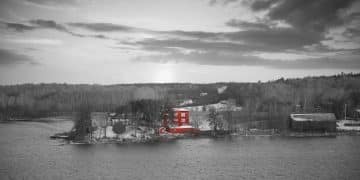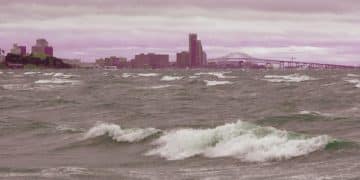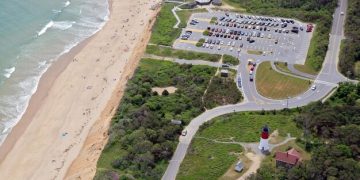Sea Level Rise Projections: US Coastline Forecast by 2100

The latest projections for sea level rise along the U.S. coastline by 2100 indicate a significant increase, with estimates ranging from 1 to 8 feet or more, depending on greenhouse gas emission scenarios and regional factors.
Understanding what are the latest projections for sea level rise along the US coastline by 2100 is crucial for coastal communities, policymakers, and anyone concerned about the future. The rising sea levels pose a direct threat to coastal ecosystems, infrastructure, and economies, demanding a comprehensive understanding of the potential impacts and necessary adaptation strategies.
Understanding Sea Level Rise: An Overview
Sea level rise is a critical consequence of climate change, driven by thermal expansion of water and melting ice sheets and glaciers. This phenomenon poses significant challenges to coastal regions worldwide, and the U.S. coastline is particularly vulnerable. To fully grasp the implications, it’s essential to understand the key factors contributing to sea level rise and the methodologies used to project future levels.
Global vs. Regional Sea Level Rise
While global sea level rise provides an overall picture, regional variations are crucial for local planning and adaptation. Factors like land subsidence, ocean currents, and gravitational effects can cause significant differences in sea level rise along different segments of the U.S. coastline.
Key Drivers of Sea Level Rise
- Thermal Expansion: As ocean temperatures rise, water expands, increasing sea levels.
- Melting Ice: Glaciers and ice sheets in Greenland and Antarctica are melting at an accelerated rate, adding substantial volumes of water to the ocean.
- Land Subsidence: In some coastal areas, the land is sinking due to natural geological processes or human activities like groundwater extraction, exacerbating the effects of sea level rise.
The precise impact of sea level rise varies substantially from one location to another due to a complex interplay of contributing factors. These include the rate of ice melt, regional ocean currents, and changes in land height. Therefore, projections must incorporate these regional factors to provide accurate and actionable insights for local communities.
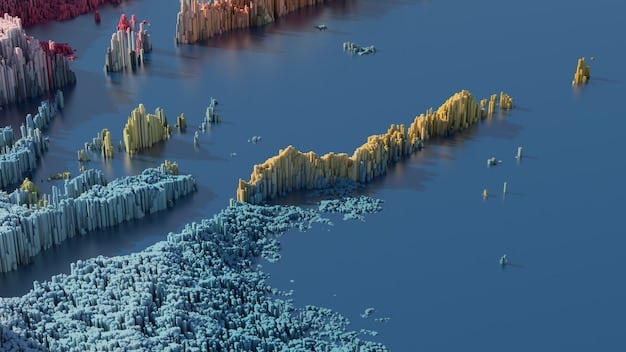
Latest Projections for the U.S. Coastline
The latest projections for sea level rise along the U.S. coastline by 2100 come from various scientific organizations and climate models. These projections consider different greenhouse gas emission scenarios, offering a range of possible outcomes. Understanding these projections is essential for informed decision-making and effective adaptation planning.
NOAA’s Sea Level Rise Scenarios
The National Oceanic and Atmospheric Administration (NOAA) provides comprehensive sea level rise scenarios for the U.S. These scenarios range from “low” to “extreme,” depending on the trajectory of greenhouse gas emissions and the stability of ice sheets. Under a high-emission scenario, NOAA projects that sea levels along the U.S. coastline could rise by 3.5 to 8 feet by 2100.
Intergovernmental Panel on Climate Change (IPCC) Assessments
The IPCC’s assessment reports also offer projections for sea level rise, incorporating global data and models. These reports highlight the uncertainty in future sea level rise, particularly concerning the contribution of ice sheet melt. Their projections generally align with NOAA’s, indicating that significant sea level rise is virtually certain, with the magnitude depending on future emissions.
Regional Differences in Projections
- East Coast: Expected to experience higher sea level rise due to factors like the slowing of the Gulf Stream.
- Gulf Coast: Highly vulnerable due to low-lying land and subsidence, potentially facing some of the most significant impacts.
- West Coast: Although generally less vulnerable due to geological uplift in some areas, the West Coast is still susceptible to erosion and coastal flooding.
In summary, the latest sea level rise projections paint a concerning picture for the U.S. coastline. These projections provide a crucial foundation for developing strategies to mitigate the impacts of rising sea levels and protect vulnerable coastal communities.
Impacts of Sea Level Rise on Coastal Communities
The impacts of sea level rise on coastal communities are far-reaching, affecting everything from infrastructure and ecosystems to economies and public health. Understanding these potential consequences is vital for preparing and implementing effective adaptation strategies.
Threats to Infrastructure
Rising sea levels can damage or destroy critical infrastructure, including roads, bridges, ports, and wastewater treatment plants. Coastal flooding can inundate transportation networks, disrupting supply chains and emergency services. Saltwater intrusion can corrode underground pipes and foundations, leading to costly repairs and replacements.
Ecosystem Degradation
Coastal ecosystems, such as wetlands and mangroves, provide valuable services like storm surge protection and habitat for diverse species. Sea level rise can inundate these ecosystems, leading to habitat loss and reduced biodiversity. Saltwater intrusion can also harm freshwater ecosystems, impacting water quality and availability.
Economic Consequences
- Property Values: Homes and businesses in coastal areas may lose value as the risk of flooding increases.
- Tourism: Coastal tourism, a significant economic driver for many regions, could suffer as beaches erode and coastal amenities are damaged.
- Fisheries: Changes in water temperature and salinity can disrupt fish populations, impacting commercial and recreational fisheries.

Adaptation Strategies for Coastal Regions
Given the inevitability of some degree of sea level rise, coastal communities must implement adaptation strategies to minimize the negative impacts. These strategies can range from hard engineering solutions to nature-based approaches and policy changes.
Hard Engineering Solutions
Hard engineering approaches involve constructing physical barriers to protect coastal areas from rising sea levels. Examples include seawalls, levees, and surge barriers. While these solutions can provide effective protection, they can also be costly and have negative environmental impacts.
Nature-Based Approaches
Nature-based solutions utilize natural ecosystems to provide coastal protection. Examples include restoring wetlands, planting mangroves, and creating living shorelines. These approaches can be more sustainable and provide additional benefits, such as habitat creation and carbon sequestration.
Policy and Planning Measures
- Land Use Planning: Implementing zoning regulations that restrict development in vulnerable coastal areas.
- Building Codes: Adopting building codes that require new construction to be elevated or flood-proofed.
- Managed Retreat: Strategically relocating communities and infrastructure away from the most vulnerable areas.
Adaptation strategies require careful planning and coordination among various stakeholders, including governments, businesses, and local communities. It’s also essential to consider the social and economic impacts of these strategies, ensuring that they are equitable and sustainable.
The Role of Mitigation in Curbing Sea Level Rise
While adaptation is crucial for dealing with the inevitable impacts of sea level rise, mitigation efforts are necessary to curb the rate of sea level rise in the long term. Mitigation involves reducing greenhouse gas emissions to slow down global warming and its associated effects.
Reducing Greenhouse Gas Emissions
The primary goal of mitigation is to reduce the amount of greenhouse gases released into the atmosphere. This can be achieved through various measures, such as transitioning to renewable energy sources, improving energy efficiency, and promoting sustainable transportation.
The Paris Agreement
The Paris Agreement is an international accord that aims to limit global warming to well below 2 degrees Celsius above pre-industrial levels. Achieving this goal would significantly reduce the magnitude of future sea level rise.
Individual Actions
- Reducing energy consumption by using energy-efficient appliances and lighting.
- Driving less by walking, biking, or using public transportation.
- Supporting policies that promote renewable energy and reduce carbon emissions.
Mitigation and adaptation are complementary strategies that must be pursued simultaneously to address the challenges of sea level rise effectively. By reducing greenhouse gas emissions and implementing adaptation measures, we can protect coastal communities and ecosystems for future generations.
Future Research and Monitoring Efforts
Continued research and monitoring are essential for improving our understanding of sea level rise and refining projections. These efforts can help us better anticipate future impacts and develop more effective adaptation and mitigation strategies.
Advancements in Climate Modeling
Scientists are continuously working to improve climate models, incorporating new data and refining algorithms. These advancements can lead to more accurate projections of sea level rise, particularly concerning the contribution of ice sheet melt.
Monitoring Sea Level and Ice Sheet Dynamics
Long-term monitoring of sea level and ice sheet dynamics is crucial for tracking changes and validating model projections. Satellite observations, tide gauges, and field measurements provide valuable data for understanding these complex systems.
Community Engagement and Education
- Public Awareness Campaigns: Educating the public about the risks of sea level rise and the importance of adaptation and mitigation.
- Citizen Science Programs: Engaging community members in data collection and monitoring efforts.
- Stakeholder Collaboration: Fostering partnerships between scientists, policymakers, businesses, and local communities to address the challenges of sea level rise collaboratively.
Through ongoing research, monitoring, and community engagement, we can build a more resilient and sustainable future for coastal regions.
| Key Point | Brief Description |
|---|---|
| 🌊 Sea Level Rise | Driven by thermal expansion and melting ice, threatening coastal areas. |
| 📊 Projections by 2100 | Estimates range from 1 to 8 feet, depending on emission scenarios. |
| 🏘️ Impacts | Include infrastructure damage, ecosystem degradation, and economic losses. |
| 🛡️ Adaptation | Strategies include hard engineering, nature-based solutions, and policy changes. |
Frequently Asked Questions
▼
The primary drivers are thermal expansion of ocean water due to warming and the addition of water from melting glaciers and ice sheets. Human activities leading to increased greenhouse gas emissions accelerate these processes.
▼
Scientists use climate models that incorporate data on ocean temperatures, ice sheet dynamics, and greenhouse gas emissions. These models generate scenarios estimating the range of possible future sea levels.
▼
The East Coast and Gulf Coast are particularly vulnerable due to factors like land subsidence and the slowing of the Gulf Stream. However, all U.S. coastal regions face increased risks of flooding and erosion.
▼
Individuals can reduce their carbon footprint by using energy-efficient appliances, driving less, and supporting policies that promote renewable energy. Collective action is crucial for significant impact.
▼
Adaptation strategies include building seawalls, restoring wetlands, implementing stricter building codes, and planning for managed retreat from the most vulnerable areas. A combination of approaches is often necessary.
Conclusion
Understanding the latest projections for sea level rise along the U.S. coastline by 2100 is crucial for preparing for future challenges. By combining mitigation efforts to reduce greenhouse gas emissions with adaptation strategies to protect coastal communities, we can work towards a more sustainable and resilient future.

